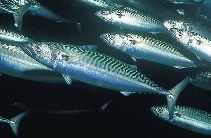 |
 |
 |
 |
 |
 |
 |
 |
 |
 |
 |
 |
 |
 |
 |
 |
 |
 |
 |
 |
 |
 |
 |
 |
 |
 |
 |
 |
 |
 |
 |
 |
 |
 |
 |
|
|
 |
|
|
|
 |
|
|
|
 |
|
|
|
Mackerel |
|
|
|
|
|
|
|
 |
|
|
|
|
|
|
|
Distribution: |
|
|
|
|
|
The Atlantic Mackeral is a very common fish to be found all around the coast of Ireland. There is no particular area that produces better than others as all coasts have their spots that will shoal fish. The Mackeral although plentiful, is not what it once was. There was once a time when you could drop a line almost anywhere and pick up a few. These days it can be a little more tricky... |
|
|
|
|
|
|
|
|
|
|
|
Habitat: |
|
|
|
|
|
Mackeral are a fast growing fish and any under 1 lb in weight are what are known as yearlings. These fish during mid to late summer have reached a size that actively shoal together and seek out areas of strong tidal currents around areas such as headlands that heard their prey together. It is here they hunt their food. Mackeral tend to swim mid water above sandy bottoms and can be found in any depth of water but usually about 20 - 40 ft down. Sand banks holding stocks of sandeels are another sure bet. |
|
|
|
|
|
|
|
|
|
|
|
Baits: |
|
|
|
|
|
When the summer shoals arrive, they feed almost exclusively on young sprats, fry, sandeels and shoaling shrimp. As such fish baits do catch them and will attract them to the hook. Mackerel however are voracious feeders in direct compotition with their neighbour and so it is movement that really attracts their attention. For this reason Lures tend to produce more bites. |
|
|
|
|
|
|
|
|
|
|
|
Tides and Weather: |
|
|
|
|
|
Mackerel are strictly day feeders, relying on light to find their food. Sunny days and clear seas generally produce more fish with a tide running hard. Both Neaps and Springs produce fish. |
|
|
|
|
|
|
|
|
|
|
|
Tactics: |
|
|
|
|
|
Without doubt it is brightly coloured feathers when jigged that produce the most mackeral. Multiple catches are common place by this method. Fishing this way with the addition of baiting the hooks with small bits of mackerel or sandeel can also increase your catch rate. Mackerel feed by day but you must first find the depth that which they are feeding. Start by dropping to the bottom and jigg away if you have no luck then try raising a little higher in the water and so on until you find fish.Keep a mental note of this and you should stay on the fish. As a general rule Mackerel will be higher in the water in the morning and will start to make their way down as the day progresses. As light falls they will be closer to the bottom. |
|
|
|
|
|
|
|
|
|
|
|
Note: |
|
|
|
|
|
Mackerel make excellent bait for other species, especially when fresh. Fresh is always MUCH better than frozen and it is worth keeping a few for this purpose. It is also worth mentioning that while they are also a great tasteing fish and the nature of catching them tends to be very easy, you should never keep more than you will need. Mackerel are a very important link in the food chain for a huge variety of species in the sea and for this reason their plentifulness should be respected. Try not to handle any fish you are not going to keep. Just shake them off. Mackerel suffer badly from loseing their scales. Crushing the barbs on your hooks is a good way to sort this problem out. |
|
|
|
|
|
|
|
|
|
|
|
Back to the Species Page |
|
|
|
|
Back to the Home Page |
|
|
|
|
|
|
|
|
|
|
|
|
 |
|
|
|
|
|
|
|

